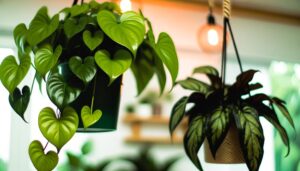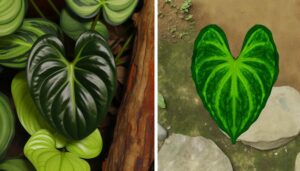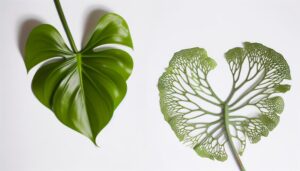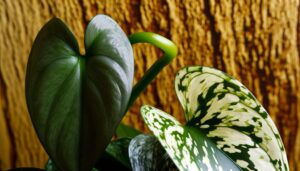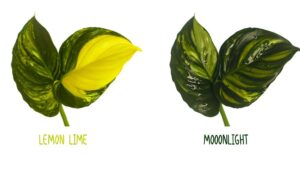Philodendron Shangri La Vs Selloum: Key Differences!
Philodendron Shangri La and Selloum, native to South American rainforests, share similarities but differ in key aspects. Shangri La possesses compact, deeply lobed, glossy green leaves with a bush-like growth habit, making it ideal for indoor spaces.
Selloum, on the other hand, features larger, wavy lobed foliage with a tree-like structure, suited for creating a sculptural, airy look. Both species thrive in humid environments and require well-aerated, nutrient-rich soil, moderate to high humidity, and temperatures between 65°F to 80°F.
Understanding these differences can aid in the best plant care and aesthetic alignment with your space. Explore further to learn more nuanced details.
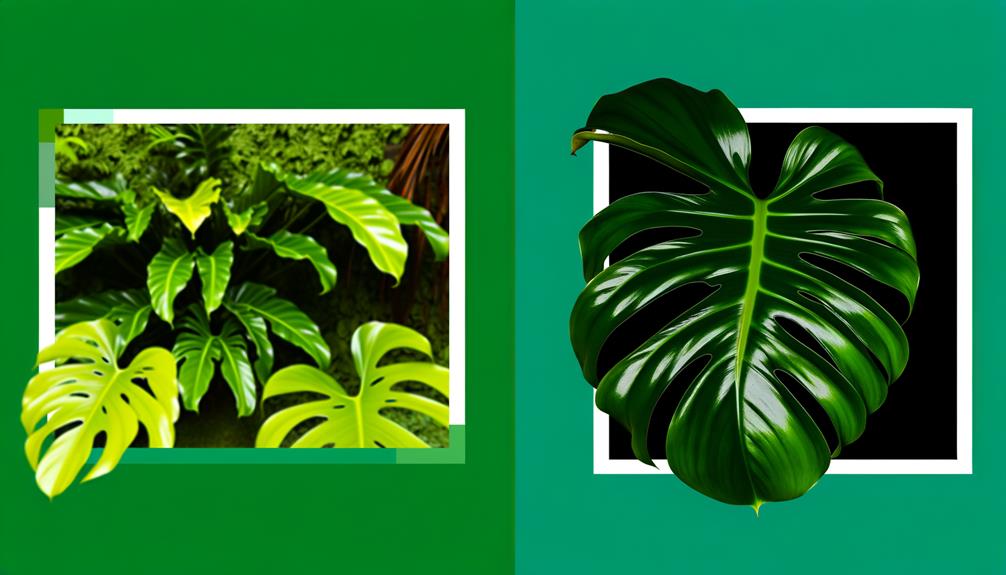
Philodendron Shangri La Vs Selloum: Key Differences
| Characteristics | Philodendron Shangri La | Philodendron Selloum |
|---|---|---|
| Leaf Size | Smaller leaves | Larger leaves |
| Leaf Shape | Wavy edges, dense growth habit | Deeply lobed, large leaves |
| Growth Habit | Bushier and more robust | Sprawling, can grow quite large |
| Size | Up to 1 meter high | Can grow up to 3 meters tall and wide |
| Light Requirements | Prefers filtered sunlight, can tolerate full sun with afternoon shade | Medium indirect light |
| Watering | Requires regular moisture, good drainage | Prefers moist soil, regular watering |
| Frost Tolerance | Can handle light frost to -1°C | Less frost tolerant |
| Common Uses | Subtropical gardens, containers, screening or privacy | Indoor plant, statement piece |
Origin and Background
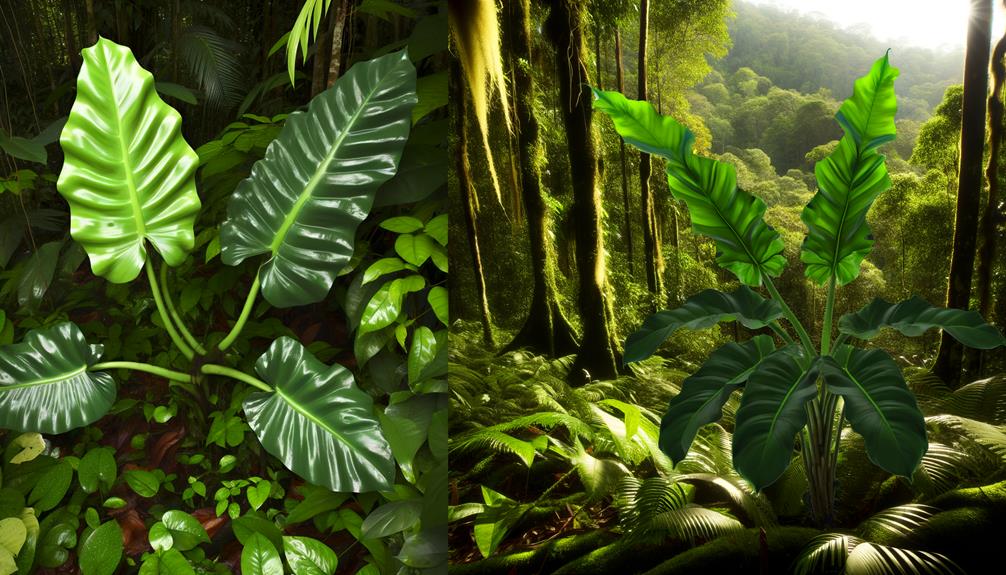
Philodendron Shangri La and Selloum, both members of the Araceae family, originate from tropical regions of South America, where they thrive in the humid, shaded understories of rainforests. These plants are well-adapted to environments characterized by consistent moisture and diffused light.
Their growth and survival are largely dependent on the rich, organic matter found in the rainforest floor, which provides essential nutrients. Both species exhibit remarkable resilience to fluctuating environmental conditions, including variations in temperature and humidity.
The evolutionary adaptations of Philodendrons allow them to efficiently utilize limited light availability, a common trait among understory flora. Understanding their natural habitats underscores the importance of replicating these conditions in cultivation to ensure optimal growth and health.
Appearance and Foliage
In comparing the appearance and foliage of Philodendron Shangri La and Selloum, distinct differences in leaf shape, color, and texture become evident.
Shangri La typically features more compact, deeply lobed leaves, while Selloum exhibits larger, more prominently lobed foliage.
Additionally, the growth habits of these plants differ significantly; Shangri La grows more bush-like, whereas Selloum tends to develop a more tree-like structure.
Leaf Shape Differences
While both the Shangri La and Selloum varieties of Philodendron exhibit lush, green foliage, their leaf shapes differ considerably, with the Shangri La displaying more compact and deeply lobed leaves compared to the broader, less dissected leaves of the Selloum.
The Shangri La’s leaves are characterized by pronounced indentations, giving them a more intricate and textured appearance. In contrast, the Selloum’s leaves are larger, with fewer and shallower lobes, presenting a more expansive and less intricate form.
These morphological differences are not merely aesthetic but may also influence the plant’s adaptability to varying light conditions and humidity levels. Understanding these leaf shape distinctions is pivotal for horticulturists and plant enthusiasts aiming to optimize their indoor or outdoor plant environments.
Color and Texture
Examining the color and texture of the foliage reveals distinct differences, with Shangri La showcasing a vibrant, glossy green surface, while Selloum tends to exhibit a slightly matte finish with a deeper green hue.
Shangri La’s leaves possess a leathery texture and a sheen that reflects light, indicating a high chlorophyll content, which enhances its visual appeal. In contrast, Selloum’s foliage, though equally robust, has a more subdued luster and a somewhat velvety feel.
The textures are not merely aesthetic; Shangri La’s glossy surface may reduce water loss through transpiration, while Selloum’s matte finish might offer better pathogen resistance. These differences in foliage characteristics underscore the unique adaptations and ecological niches these Philodendron varieties occupy.
Growth Habit Comparison
Understanding the distinct growth habits of Philodendron Shangri La and Selloum further highlights their unique characteristics, particularly regarding appearance and foliage.
Philodendron Shangri La exhibits a compact growth form, ideal for indoor environments, with deeply lobed, glossy green leaves that remain relatively close to the base.
In contrast, Selloum, also known as Philodendron bipinnatifidum, showcases a more expansive growth habit, displaying larger, deeply dissected leaves that can reach substantial sizes. Selloum’s foliage emerges from a central stem, forming a rosette pattern that can create a dramatic, tropical appearance.
Shangri La’s denser, more clustered leaf arrangement offers a bushy aesthetic, while Selloum provides a more sculptural, airy appearance. These differences cater to varying horticultural preferences and spatial considerations.
Growth Habit
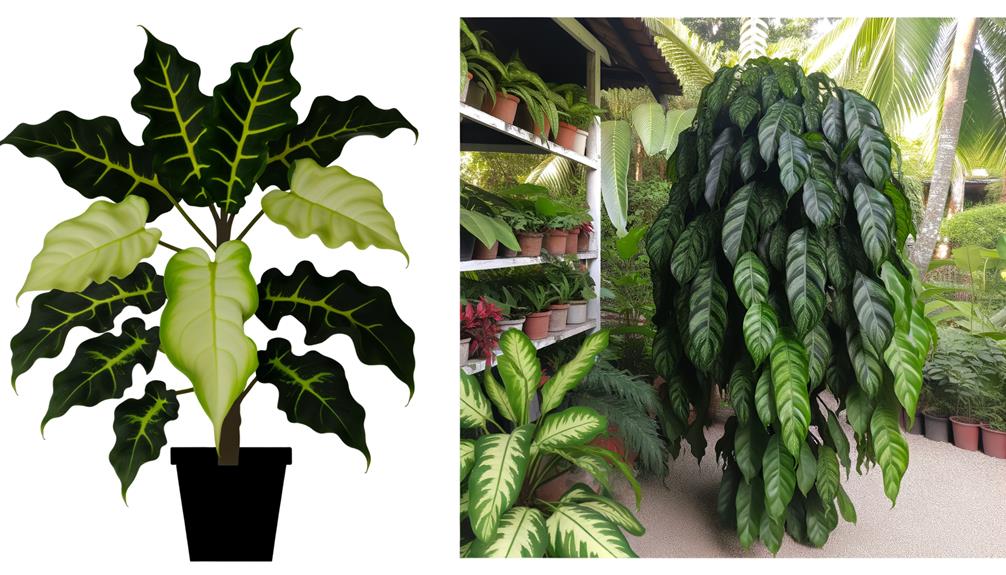
The growth habits of Philodendron Shangri La and Selloum reveal distinct characteristics in leaf shape, size, and spread, and stalk thickness.
Philodendron Shangri La typically exhibits more compact growth with smaller, deeply lobed leaves, whereas Selloum is known for its larger, more expansive foliage and broader spread.
Additionally, the stalks of Shangri La tend to be thinner and more delicate in comparison to the robust, thicker stalks of Selloum, which support its substantial leaf structure.
Size and Spread
Examining the size and spread of Philodendron Shangri La and Selloum reveals notable differences in their growth habits that can greatly impact their suitability for various indoor and outdoor environments.
Philodendron Shangri La, being a more compact variety, generally reaches a height of 2-3 feet with a similar spread, making it ideal for smaller spaces. In contrast, Philodendron Selloum, also known as Tree Philodendron, can grow up to 10 feet tall with an extensive spread of 6-8 feet, requiring more space.
| Feature | Philodendron Shangri La | Philodendron Selloum |
|---|---|---|
| Typical Height | 2-3 feet | Up to 10 feet |
| Spread | 2-3 feet | 6-8 feet |
| Growth Habit | Compact | Extensive |
| Indoor Suitability | High | Moderate |
| Outdoor Suitability | Moderate | High |
These distinctions are essential for horticultural planning and space management.
Stalk Thickness Comparison
Understanding the differences in stalk thickness between Philodendron Shangri La and Selloum is crucial for evaluating their structural integrity and overall growth habits.
Philodendron Shangri La typically exhibits thicker and more robust stalks, contributing to its compact and sturdy growth form. This enhanced stalk thickness supports the plant’s dense foliage, ensuring it can maintain its upright posture with minimal external support.
In contrast, Philodendron Selloum presents with comparatively thinner stalks, which correspond to its more sprawling and open growth habit. The thinner stalks of Selloum allow for greater flexibility and adaptability in varied environmental conditions but may require additional support as the plant matures.
These distinctions in stalk thickness significantly impact both plants’ maintenance and aesthetic considerations.
Light Requirements
Both Philodendron Shangri La and Selloum thrive best in bright, indirect light, although they can tolerate lower light conditions to some extent. Best growth occurs when they receive filtered sunlight, which mirrors their natural understory habitat in tropical forests.
Direct sunlight should be avoided as it can scorch the leaves, leading to chlorosis and necrosis. When placed in low light environments, growth may become leggy, and leaf size can diminish. To achieve optimal growth, periodic rotation of the plant is recommended.
Utilizing artificial light sources, such as fluorescent or LED grow lights, can supplement natural light in inadequately lit interiors. Monitoring light conditions is essential to maintaining the plant’s health and preventing etiolation, a condition marked by elongated stems and pale leaves.
Watering Needs
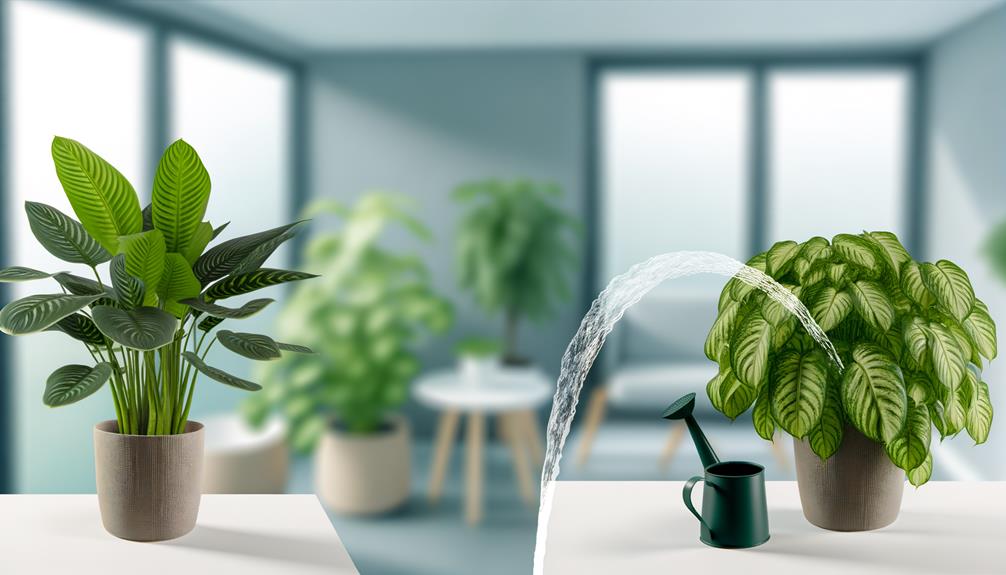
Proper watering is vital for maintaining the health of Philodendron Shangri La and Selloum, as both species require consistent moisture levels without becoming waterlogged.
Philodendron Shangri La prefers slightly damp soil, necessitating watering when the top inch of soil feels dry. Over-watering can lead to root rot, so it is important to guarantee adequate drainage.
Selloum, on the other hand, thrives with moderate watering, requiring moisture when the top 2-3 inches of the soil are dry. Both species benefit from using room-temperature water, as cold water can stress the roots.
Monitoring the humidity levels around the plants also aids in maintaining their hydration needs, as these tropical plants favor a humid environment.
Soil Preferences
Philodendron Shangri La and Selloum each exhibit specific soil preferences essential for ideal growth.
Both species thrive in well-aerated, nutrient-rich soil with excellent drainage to prevent root rot.
Understanding their best soil composition and drainage requirements is necessary for cultivating healthy plants.
Optimal Soil Composition
To thrive, Philodendron Shangri La and Selloum need a well-draining soil composition rich in organic matter, guaranteeing sufficient aeration and moisture retention.
For best growth, a balanced soil mix should be used, combining essential components to cater to their specific needs.
The ideal soil composition includes:
- Peat moss: Enhances moisture retention and provides organic nutrients.
- Perlite: Improves aeration and drainage, preventing root rot.
- Bark chips: Adds structure to the soil, promoting better airflow.
- Compost: Supplies necessary nutrients and aids in microbial activity.
- Sand: Increases drainage capabilities, reducing waterlogging risks.
This combination ensures that both Philodendron Shangri La and Selloum maintain healthy root systems, ultimately supporting robust growth and health.
Drainage Requirements
Ensuring best drainage is necessary for both Philodendron Shangri La and Selloum to prevent root rot and promote healthy growth. Both species thrive in well-aerated soil that allows excess water to escape swiftly.
An ideal soil mix comprises equal parts peat moss, pine bark, and perlite, which provides excellent moisture retention while facilitating adequate drainage. It is essential to avoid overly dense or compacted soils, as they impede root respiration and water movement.
Regular monitoring of soil moisture is recommended; the top inch should be allowed to dry out between waterings. Additionally, using pots with drainage holes further safeguards against waterlogging, ensuring that the roots remain healthy and vigorous. Proper drainage is non-negotiable for the best health of these philodendrons.
Temperature Tolerance
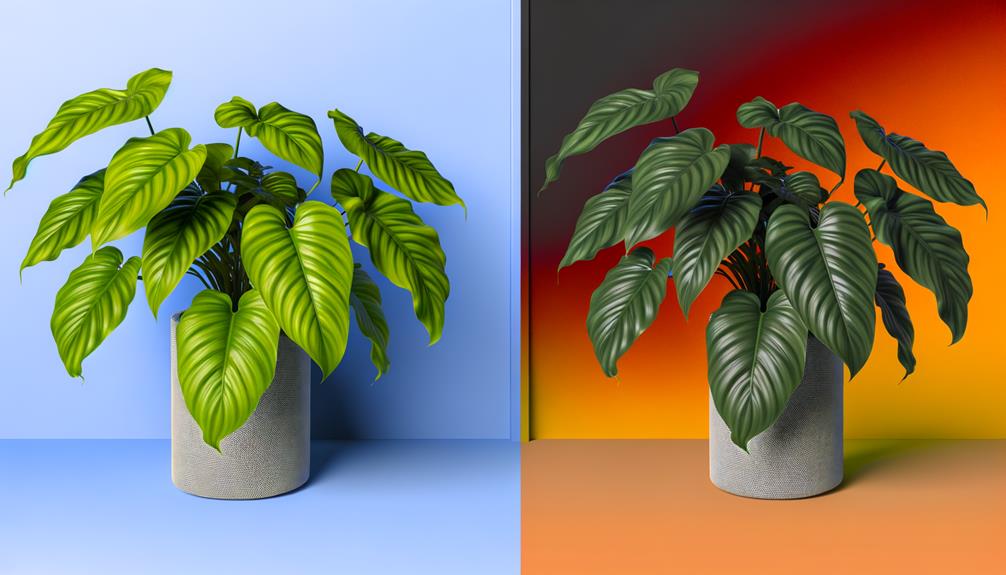
Regarding temperature tolerance, both Philodendron Shangri La and Philodendron Selloum exhibit remarkable adaptability, thriving best within a temperature range of 65°F to 80°F (18°C to 27°C). This range ensures prime growth and minimizes stress. However, deviations outside this range can adversely affect their health.
Key considerations include:
- Cold Sensitivity: Exposure to temperatures below 55°F (13°C) can cause leaf damage.
- Heat Tolerance: Extreme heat above 90°F (32°C) may lead to dehydration and leaf scorch.
- Temperature Fluctuations: Sudden changes can shock the plant, hindering growth.
- Indoor Placement: Ideal near windows but away from drafts.
- Seasonal Adjustments: Maintain stable indoor temperatures during winter to prevent cold stress.
Understanding these factors is essential for maintaining plant vitality.
Humidity Needs
While maintaining best temperature is crucial, understanding the humidity needs of Philodendron Shangri La and Philodendron Selloum is equally important for their overall health and growth.
Philodendron Shangri La thrives in moderate to high humidity levels, ideally between 60% and 80%. This range aids in optimal leaf development and prevents dehydration.
Philodendron Selloum, on the other hand, is slightly more adaptable, tolerating humidity levels from 40% to 60%, although it will flourish better in conditions above 50%.
Consistently maintaining appropriate humidity can mitigate issues such as leaf browning and pest infestations. Employing humidifiers or pebble trays can help achieve the required humidity levels, ensuring these plants maintain their lush, vibrant foliage year-round.
Pruning and Maintenance
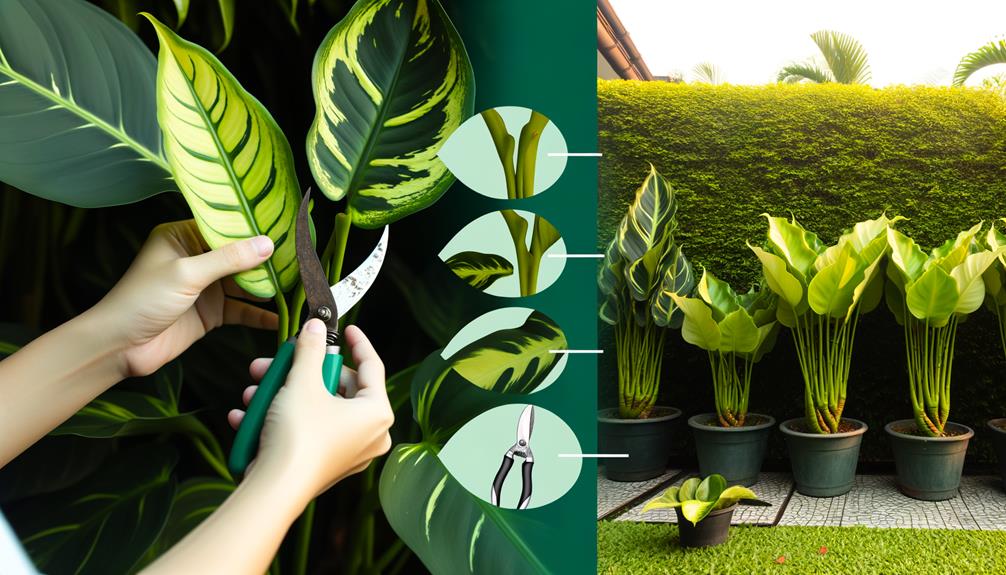
Proper trimming and maintenance are pivotal for promoting the healthy growth and aesthetic appeal of both Philodendron Shangri La and Philodendron Selloum.
Regular trimming helps to eliminate dead or yellowing leaves, improves air circulation, and stimulates new growth. It is vital to use sterilized pruning shears to prevent the spread of disease. Trimming should be carried out during the active growing season, typically spring and summer.
Key steps for effective trimming include:
- Eliminating dead or damaged leaves to prevent disease.
- Cutting back overgrown growth to maintain a compact form.
- Pruning aerial roots if they become unruly.
- Clipping back new growth tips to encourage bushiness.
- Disinfecting tools before and after use to avoid contamination.
These practices guarantee robust, vibrant plants.
Common Pests
Both Philodendron Shangri La and Philodendron Selloum are susceptible to common pests such as spider mites, aphids, and mealybugs, which can greatly impact their health and growth.
Spider mites are tiny arachnids that cause stippling and discoloration on leaves. Aphids are small insects that feed on plant sap, leading to distorted growth and a sticky residue known as honeydew. Mealybugs, identifiable by their cotton-like appearance, also feed on sap, causing yellowing leaves and stunted growth.
Regular inspection and prompt treatment with insecticidal soap or neem oil can mitigate these infestations. Ensuring ideal humidity and cleanliness around the plants can further prevent pest proliferation, maintaining the overall vigor and aesthetics of these philodendron species.
Ideal Uses
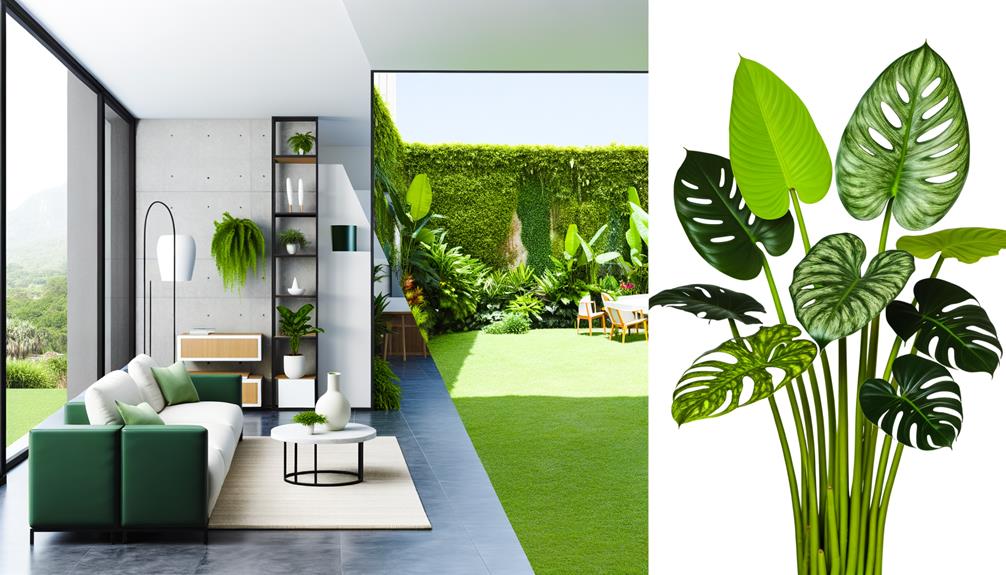
Maintaining a healthy Philodendron Shangri La or Selloum, free from pests, not only enhances their longevity but also maximizes their potential for various ideal uses in home and office environments. These plants, with their lush, green foliage, are scientifically noted for their air-purifying capabilities, making them excellent choices for indoor spaces.
Key ideal uses include:
- Air purification: Both plants absorb toxins, enhancing indoor air quality.
- Aesthetic enhancement: Their vibrant leaves add visual appeal to any setting.
- Space delineation: Utilized as natural partitions in open office layouts.
- Therapeutic benefits: Presence of greenery has been linked to reduced stress levels.
- Humidity regulation: They release moisture, contributing to a balanced indoor microclimate.
Incorporating these plants strategically can substantially improve environmental quality and aesthetic appeal.
Philodendron Selloum Shangri
Philodendron Selloum ‘Shangri-La’ is a compact, tropical plant known for its deeply lobed, dark green leaves. It’s a cultivar of the Philodendron bipinnatifidum, featuring a more manageable size, making it ideal for indoor settings.
‘Shangri-La’ thrives in bright, indirect light and requires well-draining soil. Water the plant when the top inch of soil is dry, and ensure high humidity for optimal growth. It’s also appreciated for its air-purifying qualities, making it a popular choice for home and office environments.
Conclusion
To sum up, Philodendron Shangri La and Philodendron Selloum, though often confused, display unique features in their origin, foliage, and growth patterns.
Their varied light, water, and humidity needs require customized care routines. The complexities of their upkeep and vulnerability to pests also distinguish their horticultural characteristics.
Consequently, the detailed comprehension of these distinctions can be seen as the crucial element that opens the pathway to ideal cultivation and usage, leading to flourishing specimens that enhance any botanical environment.

